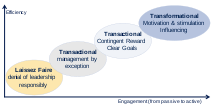Full Range Leadership Model

The Full Range of Leadership Model (FRLM) is a general leadership theory focusing on the behavior of leaders towards the workforce in different work situations. The FRLM relates transactional and transformational leadership style with laissez-faire leadership style.[1]
Background
In 1991, Bruce Avolio and Bernard Bass introduced a concept that distinguished three leadership styles, namely transactional, transformational, and laissez-faire leadership styles.[2][3] As shown in the figure, these three leadership styles can be sorted according to a leader's engagement towards her or his team.
Laissez-Faire leadership
Laissez-Faire is French for "Let them do (what they want)". This leadership style can be seen as the absence of leadership, and is characterized by an attitude avoiding any responsibility. Decision-making is left to the employees themselves, and no rules are fixed. Obviously, this style is the least active way of leading people as well as the most ineffective one (measured by the impact of the leader's opinion on the team).
Transactional leadership
The term transactional leadership refers to the transactions between a leader and followers. Transactional leadership is a style of leadership in which leaders promote compliance by followers through both rewards and punishments. Unlike transformational leaders, those using the transactional approach are not looking to change the future, they aim to keep things the same. Leaders using transactional leadership pay attention to followers' work in order to find faults and deviations.
A transactional leader follows the objective exchange of value between an employee's performance and the manager's response to it. The manager communicates clear requirements and goals to the employee and rewards achievements.[4] Some authors define transactional leadership as a "conditional reward" – the definition of the goal is negotiated between the manager and the employee, and in the event of a successful performance by the employee, the reward promised by the manager is granted.[5][6]
Transformational leadership
In contrast to the two above mentioned leadership styles, transformational leadership follows a different, more long-term oriented philosophy: Short-term, egotistic goals, are substituted by long-term, higher-ranked values and ideals. This paradigm change usually increases commitment, self-confidence, and employee satisfaction.[7] Podsakoff and colleagues distinguish six dimensions of transformational leadership:[8]
- Role model
- Future vision
- Individual support
- Promotion of group goals
- Intellectual stimulation
- High performance expectation
See also
References
- ↑ Furtner, Marco; Baldegger, Urs (29 August 2012). "Full Range Leadership". Self-Leadership und Führung (in German). Springer Fachmedien Wiesbaden: 131–188. doi:10.1007/978-3-8349-3837-4_6. Retrieved 13 August 2018.
- ↑ Bass, ed. by Bruce J. Avolio & Bernard M. (2002). Developing potential across a full range of leaderships : cases on transactional and transformational leadership. Mahwah, NJ [u.a.]: Lawrence Erlbaum Associates. ISBN 978-0805838947.
- ↑ Avolio, Bruce J. (2011). Full range leadership development (2nd ed.). Thousand Oaks, Calif.: SAGE Publications. ISBN 978-1412974752.
- ↑ Judge, Timothy A.; Piccolo, Ronald F. (2004). "Transformational and Transactional Leadership: A Meta-Analytic Test of Their Relative Validity". Journal of Applied Psychology. 89 (5): 755–768. doi:10.1037/0021-9010.89.5.755.
- ↑ Podsakoff, Philip M.; MacKenzie, Scott B.; Moorman, Robert H.; Fetter, Richard (June 1990). "Transformational leader behaviors and their effects on followers' trust in leader, satisfaction, and organizational citizenship behaviors". The Leadership Quarterly. 1 (2): 107–142. doi:10.1016/1048-9843%2890%2990009-7.
- ↑ MacKenzie, S. B.; Podsakoff, P. M.; Rich, G. A. (1 April 2001). "Transformational and Transactional Leadership and Salesperson Performance". Journal of the Academy of Marketing Science. 29 (2): 115–134. doi:10.1177/03079459994506.
- ↑ Felfe, Jörg (April 2006). "Validierung einer deutschen Version des "Multifactor Leadership Questionnaire" (MLQ Form 5 x Short) von". Zeitschrift für Arbeits- und Organisationspsychologie A&O. 50 (2): 61–78. doi:10.1026/0932-4089.50.2.61.
- ↑ Podsakoff, Philip M.; MacKenzie, Scott B.; Bommer, William H. (30 June 2016). "Transformational Leader Behaviors and Substitutes for Leadership as Determinants of Employee Satisfaction, Commitment, Trust, and Organizational Citizenship Behaviors". Journal of Management. 22 (2): 259–298. doi:10.1177/014920639602200204.